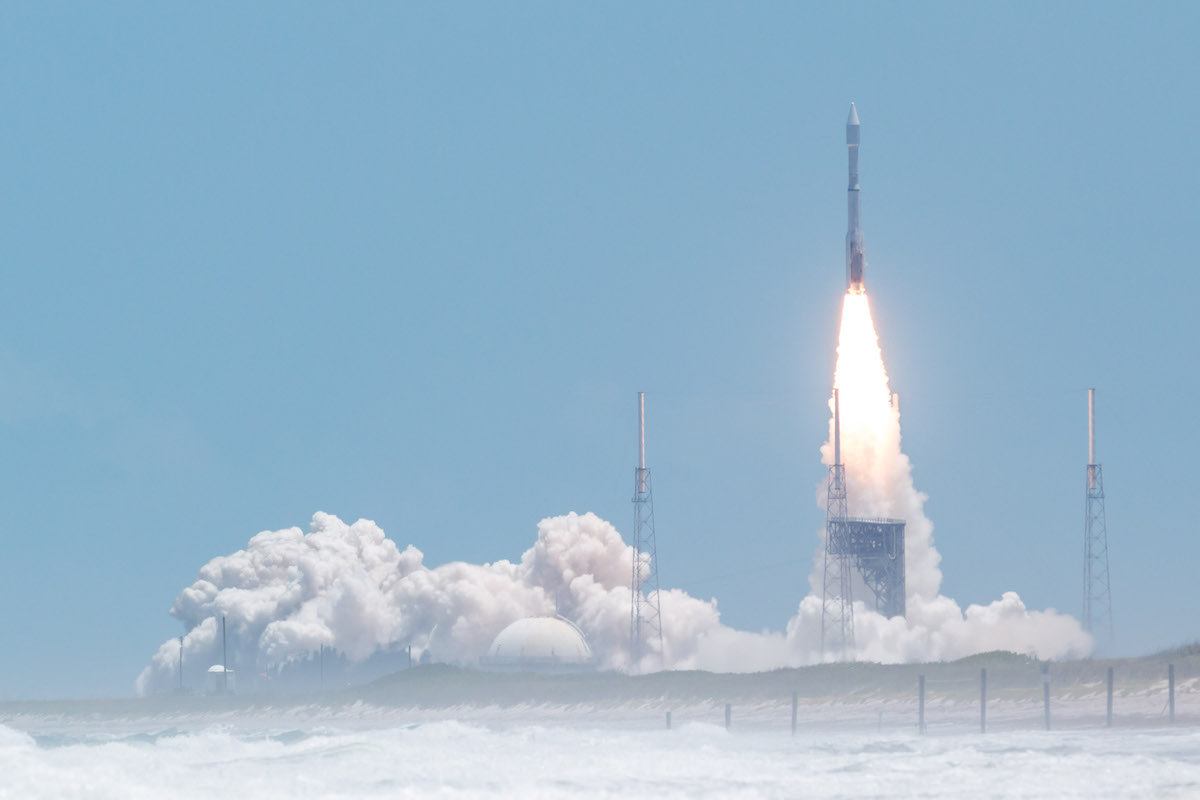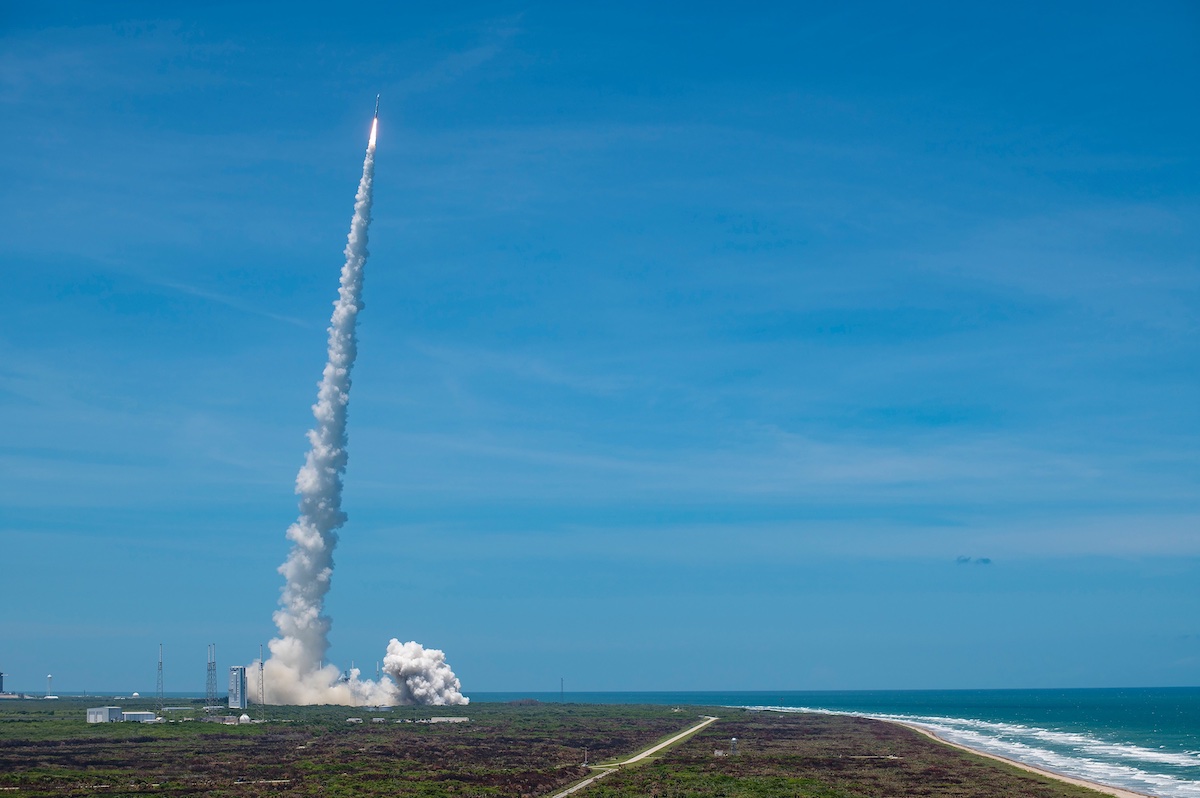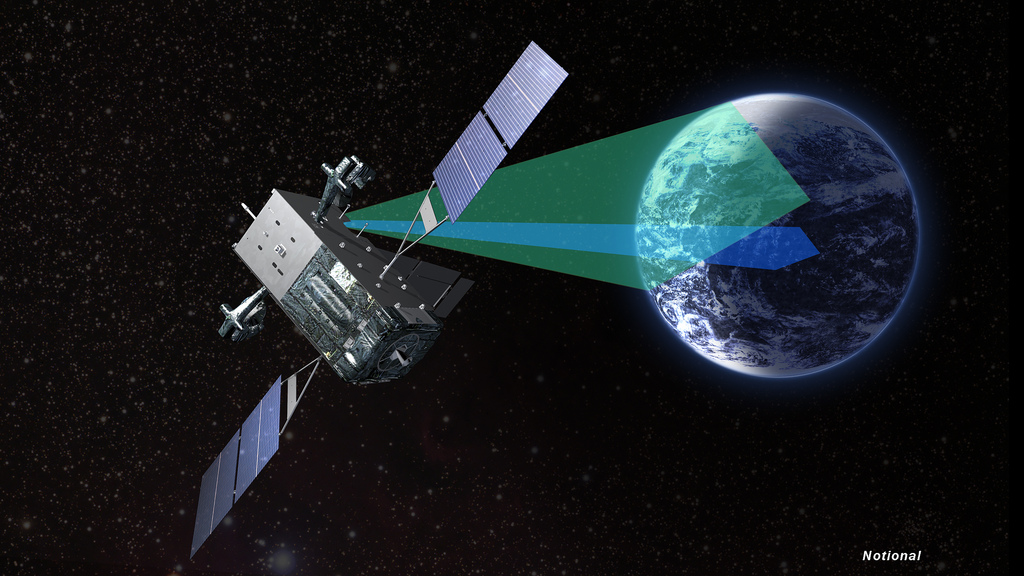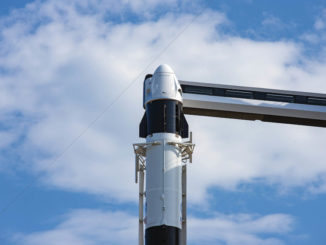
An upgraded, cyber-hardened $1 billion satellite to support the U.S. military’s missile defense systems rode into orbit from Cape Canaveral Tuesday at the tip of a United Launch Alliance Atlas 5 rocket.
Hosting a suite of sophisticated heat-seeking sensors, the Space Force’s fifth Space Based Infrared System, or SBIRS, satellite took off from pad 41 on Florida’s Space Coast on an Atlas 5 rocket at 1:37 p.m. EDT (1737 GMT) Tuesday.
The infrared payload on the SBIRS satellites can detect the hot exhaust plumes from missile launches around the world, giving U.S. and allied forces early warning of an attack. Heading for an orbital perch more than 22,000 miles (nearly 36,000 kilometers) over the equator, the SBIRS GEO 5 satellite launched Monday debuted new improvements over the previous block of four SBIRS satellites.
“SBIRS capability really remains an on-orbit guardian for us against global ballistic missile threats,” said Col. Erin Gulden, mission director for the SBIRS GEO 5 mission at the Space Force’s Space and Missile Systems Center, which manages procurement of military satellites.
ULA scrubbed a launch attempt Monday after a faulty temperature sensor caused problems during rocket fueling preparations, but the countdown Tuesday proceeded with few problems. The only minor technical issue Tuesday came when ULA tried to top off the Atlas 5’s first stage with liquid oxygen, but officials quickly cleared that snag with just a seven-minute delay.
The 194-foot-tall (59-meter) Atlas 5 rocket, weighing some 950,000 pounds, ignited a Russian-made RD-180 main engine about three seconds before liftoff from. As the countdown clock hit zero, twin strap-on solid rocket boosters fired to send the Atlas 5 into a clear afternoon sky over the Sunshine State.
Heading east over the Atlantic Ocean, the Atlas 5 exceeded the speed of sound in 47 seconds, railing a plume of exhaust from its solid rocket boosters, which generated about half of the 1.6 million pounds of thrust pushing the rocket through the atmosphere.
The twin Aerojet Rocketdyne-made boosters burned out and jettisoned about two minutes after liftoff, and the Atlas first stage’s kerosene-fueled RD-180 main engine cut off about four minutes into the mission. The bronze first stage booster then fired retro-rockets to jettison from the Atlas 5’s Centaur upper stage, which ignited an RL10 engine burning liquid hydrogen.
The RL10 engine, also made by Aerojet Rocketdyne, produced nearly 24,000 pounds of thrust for about 10-and-a-half minutes reach a preliminary parking orbit.
The Centaur upper stage then released two suitcase-size secondary “Technology Demonstration Orbiter” payloads named TDO 3 and TDO 4 for the U.S. Air Force Academy. Military officials said the two small satellites carry experimental payloads, but they did not disclose any additional details.

A second burn by the Centaur upper stage lasting nearly three-and-half minutes maneuvered the SBIRS GEO 5 spacecraft into an orbit closer to the satellite’s operating position.
ULA confirmed a successful, and on-target, deployment of the 10,700-pound (4,850-kilogram) spacecraft nearly 43 minutes after liftoff. With Tuesday’s launch, ULA has achieved 144 successful launches in as many attempts since the company formed in 2006 as a 50-50 joint venture between Boeing and Lockheed Martin.
Lockheed Martin, which built the SBIRS GEO 5 satellite in Sunnyvale, California, confirmed ground teams established a communications link with the new spacecraft after Tuesday’s launch.
The SBIRS GEO 5 satellite will use its own propulsion system to fly from its current elongated transfer orbit to reach a circular geosynchronous orbit more than 22,000 miles above Earth. Once in that orbit, ground operators will test the satellite’s infrared payload before approving SBIRS GEO 5 to enter operational service for the military.
The satellite’s velocity will be fixed with the rate of Earth’s rotation, giving the craft’s infrared early warning sensors a constant view of the same part of the planet.
The new satellite differs from the first four SBIRS GEO satellites, introducing an upgraded spacecraft design Lockheed Martin calls the “combat bus.” Lockheed Martin built the fifth and sixth SBIRS GEO satellites using its new LM 2100 platform, which the company says is the result of an “internally-funded, multi-year modernization initiative.”
In a pre-launch press briefing, Gulden said the “enhanced resiliency” of the SBIRS GEO 5 and GEO 6 satellites will “expand national intelligence gathering” and improve the military’s situational awareness.
“The need for SBIRS systems has never been more critical,” said Tom McCormick, SBIRS program manager at Lockheed Martin. “The threat of ballistic missile technology is spreading around the world.”
McCormick said SBIRS satellites detected and tracked more than 1,000 missile launches around the world in 2020.

“With early missile warning, SBIRS infrared detection capability serve as a tip of the spear, or bell ringer, that a launch has occurred and something is coming,” McCormick said. “SBIRS data informs many of our country’s defense systems, which together form a protective missile kill chain to defend our nation and our armed forces.”
According to Lockheed Martin, the LM 2100 combat bus is designed with hardening against cyber threats, along with additional spacecraft power, and enhanced propulsion and electronics. The modular design incorporates common components to streamline manufacturing, and can more easily accommodate new types of sensors to respond to innovation and new military requirements.
The LM 2100 combat bus will also be used by the next generation of missile warning satellites Lockheed Martin is building for the Space Force to replace the SBIRS fleet. The next generation of GPS navigation satellite, due to begin launching in 2026, will also use the combat bus platform.
The final SBIRS GEO satellite, GEO 6, is scheduled of launch on an Atlas 5 rocket in 2022. The first next-gen Overhead Persistent Infrared, or OPIR, satellite will launch in 2025 to begin replacing the SBIRS satellites.
Northrop Grumman builds the infrared sensors on the SBIRS satellites.
The SBIRS constellation includes a minimum of four SBIRS craft stationed in geosynchronous orbit and at least two infrared payloads in elliptical orbits aboard top secret National Reconnaissance Office spy satellites, providing polar coverage. The final two SBIRS satellites set for launch this year and next year will replenish the fleet.
Each infrared instrument package on the geosynchronous satellites includes staring and scanning sensors designed to provide visibility over an entire hemisphere, while allowing ground operators to focus the craft’s gaze on hotspots like North Korea
The military’s first SBIRS satellite launched into geosynchronous orbit in 2011, following a series of Defense Support Program early warning satellites that supplied missile launch data to military commanders beginning in the 1970s.
All five SBIRS GEO satellites have launched on Atlas 5 rockets. The rocket assigned to the SBIRS GEO 5 mission used an extra solid rocket booster — SBIRS GEO 4 launched on an Atlas 5 with a single strap-on motor — providing additional thrust to help put the spacecraft into an orbit slightly closer to the satellite’s final operating perch in geosynchronous orbit.
“SBIRS GEO 5 is the most advanced missile warning satellite built,” McCormick said. “With the launch of every SBIRS vehicle, we’re increasing our national security posture.”
Tuesday’s mission marked the 16th orbital launch from Cape Canaveral Space Force Station or the neighboring Kennedy Space Center so far this year. But it was the first launch from Florida this year by ULA, following 15 flights by rival launch company SpaceX to start 2021.
ULA launched one national security mission earlier this year from Vandenberg Space Force Base in California.
The rate of launches from Florida’s Space Coast to start 2021 outpaces the number of launches at this point in any year since the dawn of the Space Age.
The next launch from Cape Canaveral is scheduled for May 26, when a SpaceX Falcon 9 rocket will haul the next batch of Starlink internet satellites into orbit.
United Launch Alliance’s next mission is scheduled for June 23, when an Atlas 5 rocket will launch two military spacecraft, each carrying multiple experimental payloads for the Space Force and NASA.
Email the author.
Follow Stephen Clark on Twitter: @StephenClark1.



